- Italy Tours Home
- Italy Ethos
- Tours 2023
- Blog
- Contact Us
- Dolomites
- Top 10 Dolomites
- Veneto
- Dolomites Geology
- Dolomiti Bellunesi
- Cortina
- Cadore
- Belluno
- Cansiglio
- Carso
- Carnia
- Sauris
- Friuli
- Trentino
- Ethnographic Museums
- Monte Baldo
- South Tyrol
- Alta Pusteria
- Dobbiaco
- Emilia-Romagna
- Aosta Valley
- Cinque Terre
- Portofino
- Northern Apennines
- Southern Apennines
- Italian Botanical Gardens
- Padua Botanical Garden
- Orchids of Italy
Bertinoro, the ‘Balcony of Romagna’, Sits Among Gentle Hills That Produce the Golden Albana Wine.
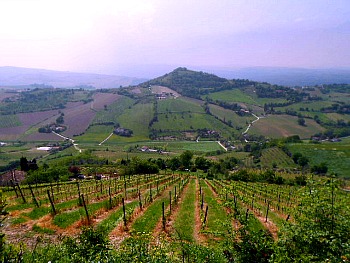
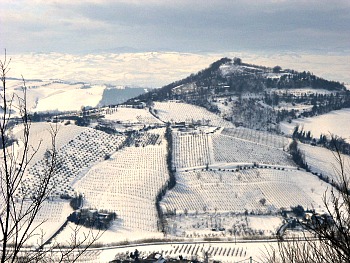
Bertinoro: A Century-old Tradition of Hospitality and Wine-making
The truly wonderful position of Bertinoro – an atmospheric hilltop town in the heart of Romagna – has earned it the nickname of ‘Balcony of Romagna’. The actual territory covered by this municipality is quite vast – from the area at the foot of the hills to the plains. Bertinoro is rooted in an attractive land famous for its wine production, and proud of its food traditions and hospitality. Near here there are also several spas (such as Fratta Terme, Castrocaro, Bagno di Romagna): all elements that unite to create a place where the quality of life still makes a difference, and which translates into a tranquil and pleasant stay for the visitor, who can fully savour the flavours of a land still in touch with its traditions (in the pictures above, a summer and winter view of the hills that surround Bertinoro, covered in vineyards).
The Medieval Town Centre
The old town centre sits on the top of a steep hill that has retained its medieval aspect in the urban structure: the ring of ancient walls, the cobweb of little streets, the narrow alleyways winding uphill – all this allows for a glimpse on the atmospheres of the past. Two of the three old gates are still well preserved: Porta San Romano (once otherwise called ‘of the Three Saints’) has a pointed arch and looks out towards Forlì; Porta Malatesta (or ‘del Soccorso’) was built in the 15th century and faces the opposite direction, towards Polenta (read below).
At the heart of Bertinoro is Piazza della Libertà, an elegant and spacious square – and probably the only flat spot in town! On one side, this space opens up to a magnificent view of the vast plains to the north, overlooking Forlì, Cesena and a long stretch of Adriatic coast between Ravenna and Rimini; the three jagged peaks of San Marino are also visible to the right in clear weather. On exceptionally clear days, the distant sight of the Dalmatian mountains appears like a mirage fluctuating above the azure sea (below is an image over the roofs and towards the plains, taken in the highest part of Bertinoro).
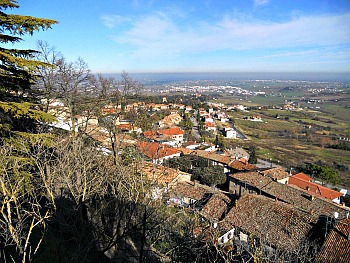
Opposite, the square is closed by the long façade of the Town Hall, which originally dates to the 14th century but was substantially rebuilt in mock medieval style in the 1930s, when a crenelation was also added (it was a time in which rebuilding according to medieval tradition was very much ‘en vogue’).
The Civic (or Clock) Tower rises above all the other buildings and its bells are dated 1526: once, when it was higher, the tower also acted as a lighthouse to guide sailors and travelers from the distant sea.
The Cathedral
The Cathedral is just to the left, and it was originally a small oratorio dedicated to St. Catherine, who is the patron saint of Bertinoro along with the Breton saints (who allegedly gave the town its name). It was entirely rebuilt and given the current appearance at the end of the 16th century in the style of Bramante, with three naves, and it is home to several paintings and impressive works of art, including the altar-piece featuring St. Catherine of Alexandria and a large wooden Crucifix carved out of a large, single piece of fig wood, which was sculpted by a pilgrim by way of thanks for the hospitality he had received – apparently still a hallmark of the area.
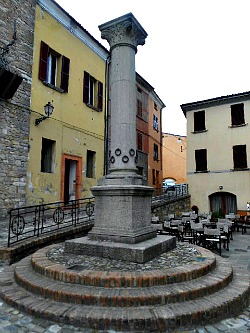
The Ring Column and the ‘Spirit of the Place’
At one end of the square, unmistakable, stands a puzzling column circled by iron rings – and this conspicuous feature is in fact not only the official symbol of Bertinoro but also, perhaps, the emblem of hospitality itself in Romagna: it is the so-called ‘Colonna dell’Ospitalità’ – also known as ‘Colonna delle Anella’ (Ring Column; pictured above) because of an ancient use.
The Ring Column is a symbol of the long-standing tradition of hospitality that has endured in Bertinoro over the centuries. It was erected in the 13th century, when it was decided that, in order to end the frequent disputes among local families about hosting foreigners, the families would be able to ‘own’ – on a rotating basis – one of the twelve rings attached to the column; then, the guests themselves would be allocated their hosts depending on which ring they had (unknowingly) attached their horse to upon arrival. The travelers visiting the town would in fact become the guests not only of the corresponding family but of the community as a whole, and would be immediately welcomed in an atmosphere of hospitality. The column was then removed and forgotten for about four centuries, when it was recovered and reinstalled in place after the restoration work carried out for the town hall; today, this old tradition – still very much at the centre of local identity – is revived by the Festival of Hospitality, which is held on the first Sunday of September.
You can tell a lot about the genius loci (the genie or ‘spirit of the place’) of Bertinoro by the sheer number of inns and taverns (usually termed osteria and trattoria in Italian) present in town: probably one of the highest ratio per capita in the whole of Italy! Certainly, there are more of them here than in all of Cesena and Forlì put together: this explains why people flock to Bertinoro from the cities all around – especially on balmy summer nights.
The Cà de Bè Wine House
One such representative is right one level under the main square: the renowned Cà de Bè (which literally reads as ‘Drinking House’ in the local dialect) is a living testimony of the wine-making traditions in Bertinoro, where one can also taste local dishes – most of them made with local products. Having said that, there are other 'osterie' dotted around all over the place: wherever you are in Bertinoro, you need only walk a few metres to bump into one ... .
Located under the magnificent terrace of Piazza della Libertà, the Enoteca Cà de Bè is a renowned venue with a panoramic view, inaugurated by the “Tribunato Vini di Romagna” and the “Ente Tutela Vini di Romagna” in 1971, where it is possible to taste some of the most famous wines of the region. Here it is hosted also a small wine museum. Outside the terrace is the “Campana dell’Albana” – a bell with interesting bas-reliefs details, and a ceramic depiction of grape-pressing.
The Torrione San Giuseppe is situated at the entrance of one of the ancient streets of Bertinoro that have retained their medieval feel over the centuries, Via delle Mura. This is a narrow, cobbled street leading down to Piazza della Libertà, which can also be reached via the ‘Custarena’ steps from the terrace of the Cà de Bè Wine House. At the base of the tower and along the street, the ancient walls of Bertinoro act as parapet.
Porta del Soccorso. Walking up via del Soccorso now – the road that leads to the castle – as the views open up over the hills of Monte Casale and Teodorano, you will eventually reach Porta del Soccorso: a small opening in the ancient walls of Bertinoro, which was elevated to the status of 'gate' after Countess Aldruda Frangipane – the proud lady of Bertinoro – dispatched in 1772 her army to give help to the city of Ancona, which was under siege from the armies of the Archbishop Christian of Magonza and Venice’s troops, then allies of the Emperor.
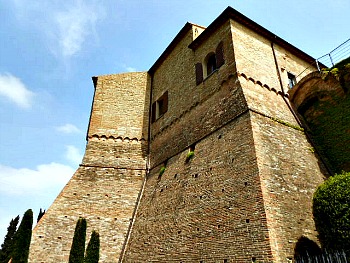
The Castle
On the highest part of town – high above the roofs – stands the imposing thousand year old Rocca (castle; pictured above), a living part of this territory since at least 1,000 years. It was erected in the first few years of the 10th century, and Frederic Barbarossa stayed there in 1177; for the first 500 years of its life it was a place of fights and passions, as in the Middle ages the Malatesti, Sforza and Borgia families fought over it for its possession, in alternating phases of war and peace; then, from 1584 onwards, this stronghold took a very different and specific connotation, as it became the seat of the Bishop of Bertinoro – an important Diocese, which served as focal point for religious life over a vast territory.
Recently, the building has been superbly restored, and it now hosts an unusual and interesting institution, unique in its genre: the Centre for Liturgical Furnishing and Religious Dress, then renamed Inter-religious Museum (Museo Interreligioso). The Rocca also houses the summer campus of the University of Bologna, which promotes various initiatives synergically connected with the local economy and cultural context. Inside the castle there are several frescoed rooms, dating to the 15th and 16th century; the highlight is the wonderful dining room, which has frescoes by Maestro Corradino (1613), depicting scenes of the life of St. Francis and St. Romuald (below, another image of the Rocca, crowning the top of the hill – Bertinoro’s highest point).
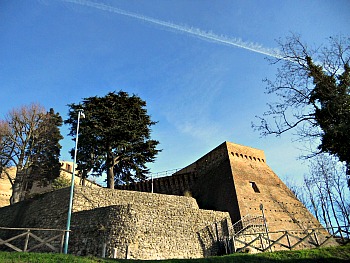
The Inter-religious Museum
The Inter-religious Museum is hosted in the lower part of the building and in the subterranean section (which were formerly the prisons and water cistern respectively), which have been painstakingly restored. This is a permanent collection of works of art, documents and reconstructions – unique in Italy – dedicated to three monotheistic religions: Judaism, Christianity and Islam; each of them is observed in its specificity, but relations and commonalities are drawn too. This Museum is born out of the desire of deepening the knowledge of these three religions, in the hope to favour dialogue, comprehension and mutual respect. It offers the possibility to discover – first and foremost – the character of Abraham, whose representation opens the exhibition space with a mosaic, and who is seen as common root of the three different faiths.
The magical and atmospheric setting of the Rocca – made even more compelling by the lighting arrangement – thus becomes a precious container for the exhibited material. The visit is structured like an interesting encounter of history and present-day religion, as beside the works of art are presented – often with the help of multimedia devices – aspects related to the actuality of religious practices that aim to show daily life and worship, and how these accompany the believer now as well as they did in the recent past. Also, the relationship between faith and the Divine word is drawn through a rich display of old and modern editions of sacred texts. Towards the end of the visit – in a wide room in the subterranean section – suffering, injustice and the relationship with evil are represented through a series of contemporary sculptures.
The visit is very educational and beautifully displayed, but in my view – for completeness – other religions could have been taken into account too; however, in the light of the fact that the initiative has come from the headquarters of the local Diocese (hosted for so long within these premises), the choice of these three monotheistic religions makes sense.
In addition to the exhibition in the interior (which has quite restricted opening times – so check before a visit), sweeping views open up outside, from the so-called Dante’s balcony (still part of the Museum) as well as from the castle ramparts and the surrounding fields (a final view of the Rocca is presented below, with the entrance to the Inter-religious Museum).
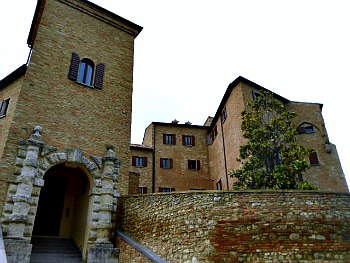
Piazza Ermete Novelli. Ermete Novelli was one of the great masters of Italian drama, and came from an ancient, noble family of Bertinoro. In 1900, he founded Italy's first stable theatre in Rome; therefore, the municipality has dedicated a quiet corner of his hometown to his memory (a corner of the square is portrayed below, with the small Baroque church of San Silvestro).
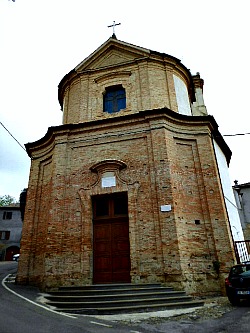
Bertinoro has a roughly circular shape, and if you continue down from the castle along via Oberdan and into via del Fossato you will reach the ancient Jewish ghetto in Contada Mainardi – and here is a living connection with the Inter-religious Museum, as this was the birthplace of Rabbi Ovadyah Yare, who lived here until the end of the 15th century and is known throughout the Jewish world as The Great Master of Bertinoro.
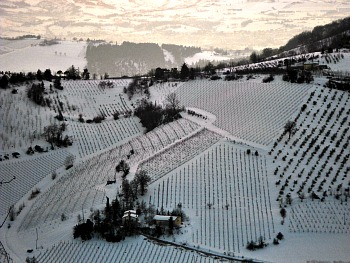
The Hills of Bertinoro and Polenta
All along the itinerary among the Bertinoro hills there are extensive vineyards to be seen, as well as specialized plantations of fruit trees – especially peaches, which colour the hillsides of an incredible pink in the early spring (above is an image of the hillsides in winter, when the patterns formed by vineyards and orchards becomes particularly mesmerising). This is definitely a magical time of year in which to visit the area: cherries and apricots add a splash of white to the palette, while isolated almond trees are the first to blossom in early March – sometimes even as early as late February – bearing witness to the mildess of the climate, which benefits from the vicinity of the sea and has some Mediterranean elements to it too (most noticeably in the presence of olive groves). I always try and pay a visit to Bertinoro at this most enchanting of times – and I like to compare it to a small ritual, almost religious in its nature: a local version of what Japanese people do when cherry blossom time comes....
The hills here are dotted with small hamlets: Collinello, Tassello, S. Mamante, Bracciano, Paderno – place names that often make a reference to their Langobards origin, where one can still find traditional inns and taverns that – in the words of the Italian poet Giosué Carducci – ‘smell hay rather than roses’.
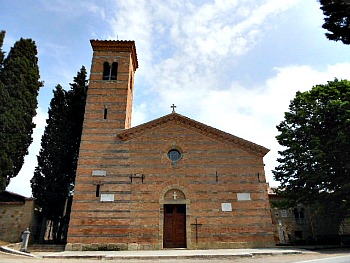
Decidedly, the most interesting of these villages is Polenta, immersed in a dream-like landscape of gently rolling hills. Polenta is an old settlement built on a hilltop crowned with rows of cypresses, and its highlight today is the ancient parish church of San Donato, which has just been restored and reopened (it is pictured above). Originally dating to the 10th century, the church was heavily remodeled in the 18th century; this was in order to bring the building back to its former purity of lines. Still to this day, San Donato is shaped like a basilica with a simple Roman structure, especially noticeable in the interior. The church also hosts an atmospheric underground crypt (see an image of the interior below).
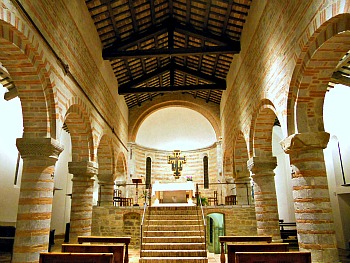
The literary echoes of the place add to its charm: the Italian poet Giosué Carducci – already mentioned above – is commemorated with a bust, surrounded by the coats of arms donated by several towns and cities nationwide (see the picture below). The famous poet – who used to sojourn in a villa in the vicinity – praised this place in his ode “The Church of Polenta” (1897).
According to tradition, Dante also stopped here to pray while walking from Arezzo to Ravenna: although this cannot be proved for sure, what is certain is that Dante mentioned Polenta in his Divine Comedy. Whatever the truth, this place is almost magical; it has a mesmerising quality to it, and still makes for a quiet, reflective stop.
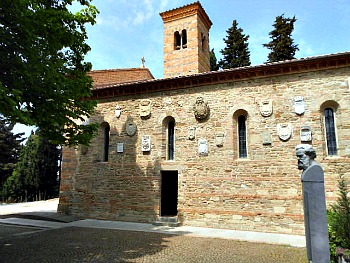
Around Bertinoro and Beyond: Longiano
Longiano was awarded the title of ‘ideal village’ in 1992, and since 2005 it has a TCI (Italian Touring Club) ‘Bandiera Arancione’ flagship. The ‘Orange Flag’ is a major accolade awarded for the quality of life and hospitality in towns with fewer than 15,000 inhabitants throughout Italy.
History
The presence of a strategic citadel to defend the local population against Lombard incursions was mentioned as early as 1059, but the Castle of Longiano’s period of greatest splendor was as the residence of the House of the Malatesta. The only trace of the Republic of Venice’s few years of dominance is the monumental fountain in the castle’s courtyard. The town later passed to the Papal State. In 1790 Longiano fell – like the rest of Romagna – under Napoleon’s rule. Then followed the events of the Risorgimento. The little town was a stronghold of the Gothic Line during WW2, when vast air-raid shelters were built under the castle.
Visiting Longiano
The ancient village is enclosed within a double ring of walls pierced by three Medieval gateways. The Malatesta castle is a massive – yet elegant – presence dominating the old centre. The Civic Tower commands a breathtaking view stretching as far as the Adriatic sea. The fully restored castle compound houses the Fondazione Balestra, a splendid collection of Modern figurative art with over 3,000 works, mostly by 20th century Italian artists, and an important collection of graphic works by major international artists. Another cultural landmark in Longiano is the civic theatre, Teatro Petrella, inaugurated in 1870. It was reopened in 1986 following a careful restoration, and it continues to host world-renowned artists.
Next to the theatre is the Centro Culturale San Giacomo, which houses the Public Library’s former historical book-stock. The Cultural Centre also hosts the ‘Galleria delle Maschere’ – a collection of 31 bronze ‘Commedia dell’Arte’ masks. Longiano boasts unique museums of international relevance, such as the ‘Museo Italiano della Ghisa’ (cast-iron), with original 19th and 20th-century street furniture from major European cities; the collection is one of the foremost of its kind in the world. The Oratorio di San Giuseppe (St. Joseph’s Oratory) is a Baroque jewel; it now contains the ‘Museo d’Arte Sacra’ (Museum of Sacred Art), with ancient church furnishings and other items. The museum tour ends with the ‘Museo del Territorio’, with its innumerable exhibits of traditional crafts and costumes. Other interesting places to visit include the Collegiate Church of San Cristoforo – with its many beautiful paintings – and the Santuario del Santissimo Crocifisso (Shrine of the Holy Cross), which houses a magnificent 13th century cross. The old Turchi olive mill – now fully restored – is in Balignano, a small hamlet near Longiano.
The Teatro Petrella offers performances of prose, music and dance throughout the year, held in the theatre itself or in the villages’ largest squares. ‘Longiano dei Presepi’ is held in December and Januray each year: it comprises a series of cultural, theatrical and gastronomic events centered around a display of Nativity scenes scattered throughout the village streets (the old mechanical Nativity is particularly interesting). In June, the ‘Sagra della Ciliegia’ (‘Cherry Fair’) celebrates this delicious red fruit, widely grown around Longiano. The ‘Settimana Longianese’ (‘Longiano Week’) features a range of entertainment and food-and-wine events centered around the solemn celebrations and the procession for the Feast of the Holy Cross, on July, 26th every year. The ‘Sagra dell’Olio e dell’Ulivo’ (‘Olive Tree and Olive Oil Fair’), in the second week of November, offers a rich calendar of games, conferences and dances – as well as an opportunity to enjoy delicious dishes of the traditional cuisine of Romagna.
Return from Bertinoro to Emilia-Romagna
Return from Bertinoro to Italy-Tours-in-Nature
Copyright © 2013 Italy-Tours-in-Nature

New! Comments
Have your say about what you just read! Leave me a comment in the box below.